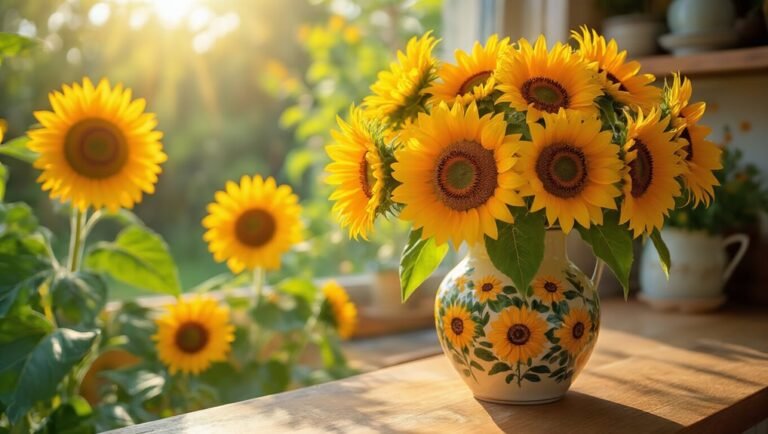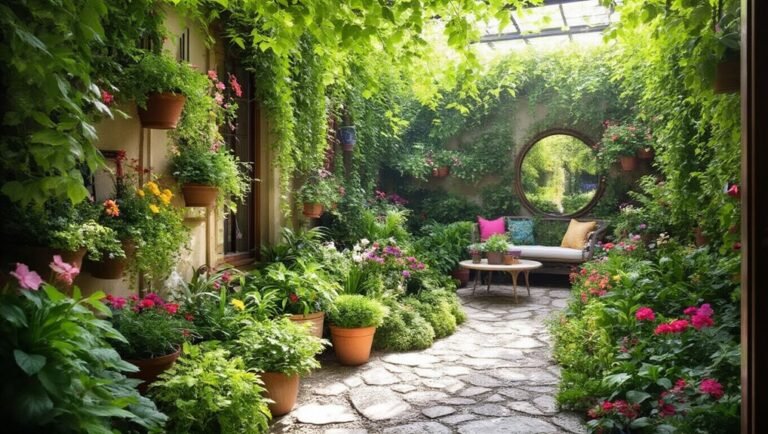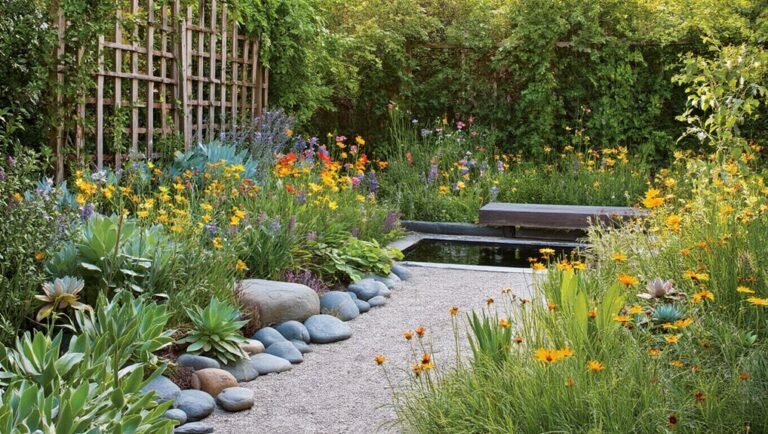Creating a budget-friendly backyard garden is easier than you think! Start by sketching a layout and using recycled materials, like wooden pallets, for added structure. Opt for growing plants from seeds to save money and include companion plants for natural pest control. Incorporate native plants for low-maintenance beauty and make the most of space with container gardening. Don’t forget to explore local plant swaps for more variety. There’s so much more you can discover!
Key Takeaways
- Start by measuring your space and observing sunlight patterns to select the best plants for your budget-friendly garden.
- Utilize repurposed materials like wooden pallets and bricks for DIY structures, such as raised beds and vertical gardens.
- Grow plants from seeds instead of buying seedlings to save money and explore a wider variety of options.
- Incorporate companion planting techniques to naturally deter pests and enhance plant growth while minimizing chemical use.
- Join local plant swaps and gardening clubs to exchange plants and supplies, reducing costs while expanding your garden’s diversity.
Start With a Plan: Design Your Garden Layout
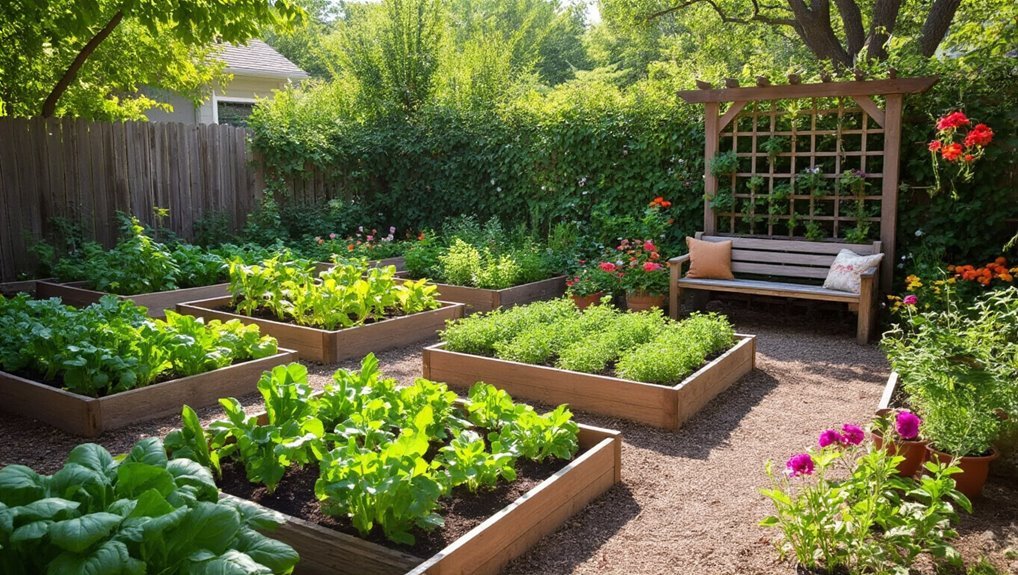
When you plan your backyard garden layout, it’s essential to consider both aesthetics and functionality. Start by measuring your space, noting sunlight patterns, and determining soil quality.
Think about how you’ll use the garden—whether for relaxation, growing vegetables, or entertaining. Sketch a rough design, placing larger plants or structures, like trellises or seating areas, first. You might also want to explore Vertical Garden Kits as a space-saving way to add lush greenery, especially if your garden area is limited.
Create pathways that make access easy, ensuring you can tend to your plants without hassle. Don’t forget to incorporate color and texture; mix flowers, shrubs, and greenery for visual appeal.
Finally, be mindful of maintenance needs; choose plants that suit your lifestyle. With a thoughtful plan in place, you’ll create a garden that’s beautiful, practical, and uniquely yours.
Consider enhancing your space with beautiful trellises to add height, support climbing plants, and introduce a striking visual element to your garden design.
Utilize Recycled Materials for Garden Structures
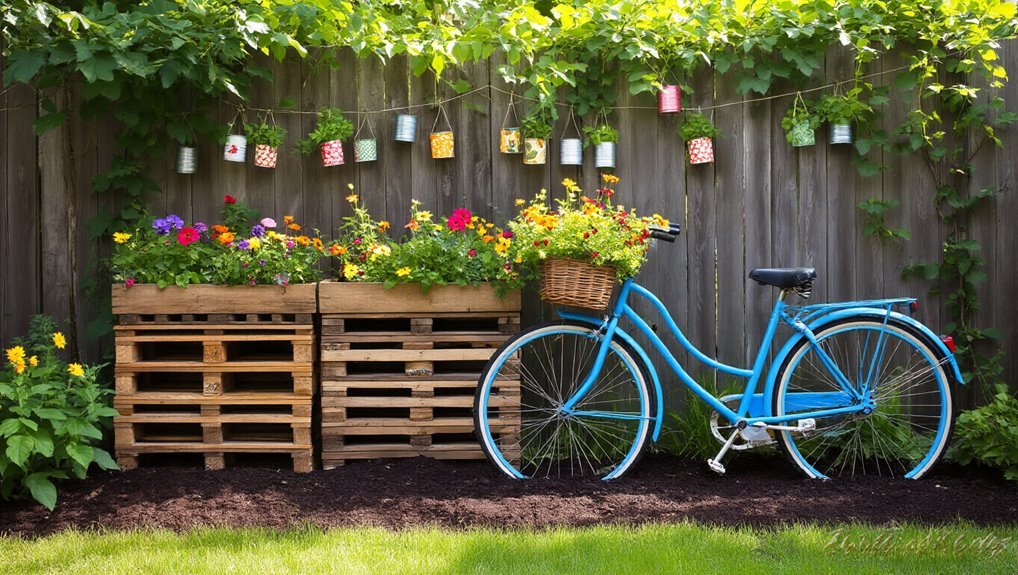
To create unique and sustainable garden structures, consider utilizing recycled materials that not only reduce waste but also add character to your space.
Old wooden pallets can be transformed into vertical gardens or compost bins. By choosing the right compost bins, you can efficiently turn kitchen scraps and yard waste into nutrient-rich soil for your plants. Use bricks or stones left from previous projects to build raised beds or pathways. Even discarded tires can serve as quirky planters!
You can repurpose metal sheets or fencing for trellises, providing support for climbing plants. Don’t forget about repurposed glass jars or bottles; they make perfect lanterns or decorative borders.
For a practical and attractive gardening solution, consider building raised garden beds from reclaimed wood or other salvaged materials to elevate your planting area and improve soil drainage.
Grow From Seeds: A Cost-Effective Approach
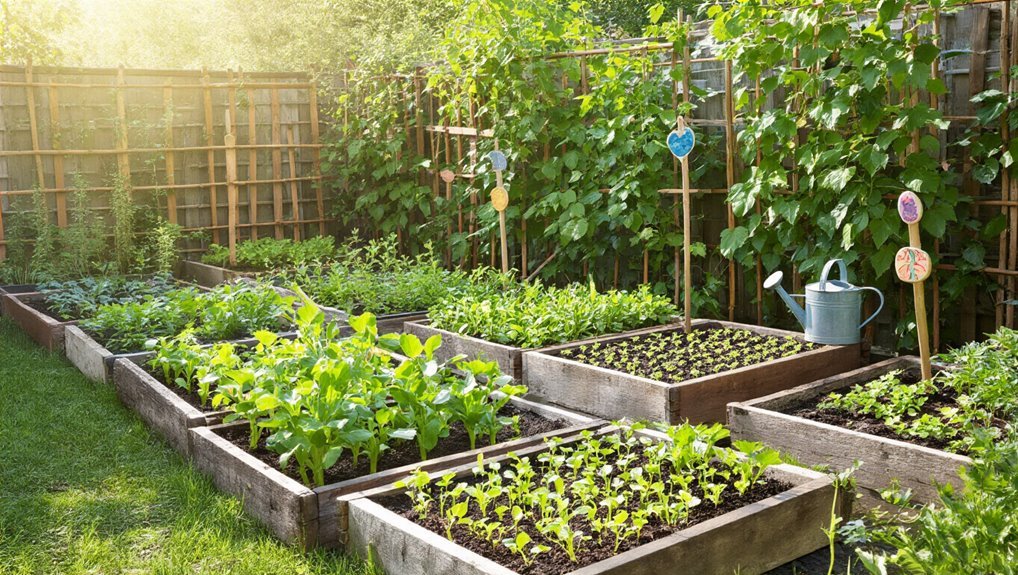
Growing your own plants from seeds can save you a significant amount of money while allowing for greater variety in your backyard garden. Instead of buying expensive seedlings, you can invest in seed packets that often contain numerous seeds for just a few dollars. This method not only gives you a wider selection of plants but also promotes a sense of accomplishment. For even better germination rates, consider using seedling heat mats to provide consistent warmth to your seeds during sprouting.
Here’s a quick comparison of seed types:
| Seed Type | Cost per Packet | Germination Time |
|---|---|---|
| Vegetable Seeds | $1 – $3 | 7 – 21 days |
| Flower Seeds | $1 – $4 | 7 – 30 days |
| Herb Seeds | $1 – $5 | 7 – 14 days |
With a little patience, you’ll enjoy a flourishing garden without breaking the bank! Starting seeds is even easier with essential seed starting kits, which provide everything you need for successful germination and healthy seedlings.
Companion Planting for Pest Control
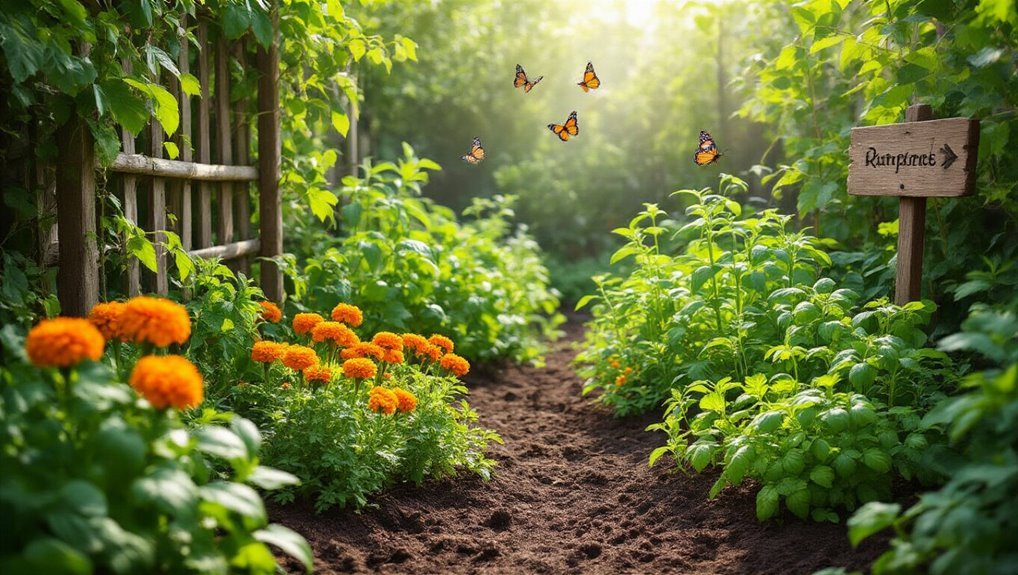
Companion planting can significantly enhance your garden’s health and productivity, especially when it comes to pest control. By strategically placing certain plants together, you can deter harmful pests and boost the growth of your crops.
For instance, marigolds repel nematodes and aphids, making them an excellent companion for vegetables like tomatoes. Likewise, planting basil near tomatoes not only improves their flavor but also wards off tomato hornworms. Integrating organic pest control solutions with companion planting provides an even more robust defense against garden pests and reduces the reliance on synthetic chemicals.
Consider using garlic to protect your garden from aphids and whiteflies, as its strong scent keeps these pests at bay.
Additionally, pairing carrots with onions can confuse pests who might target one plant. Embrace these natural alliances in your garden to create a thriving, pest-resistant environment without breaking the bank.
You can also incorporate insect repellent plants such as citronella into your garden, which naturally help deter common pests and reduce the need for chemical sprays.
Create a Compost Bin for Natural Fertilizer
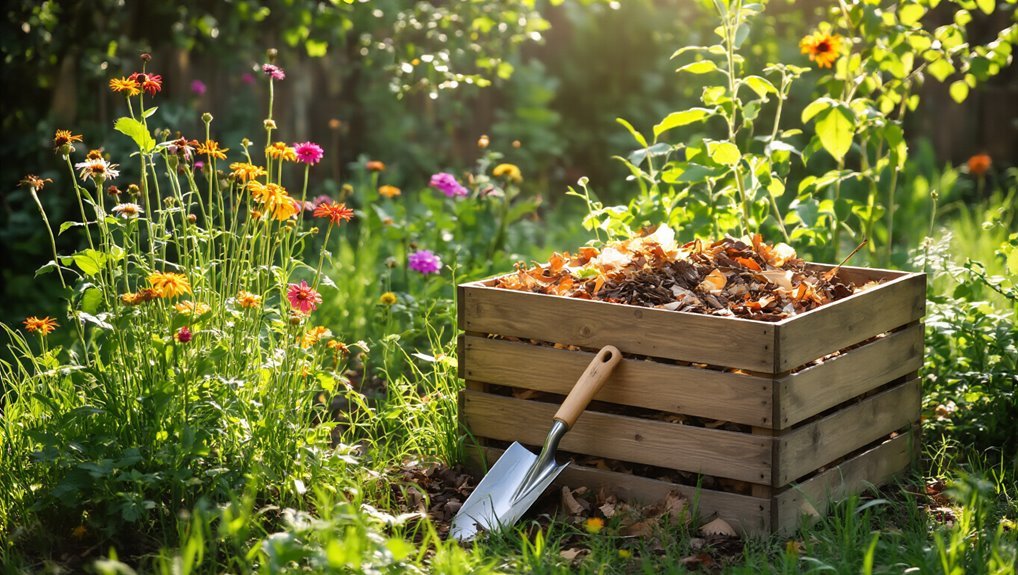
Creating a compost bin is a simple yet effective way to enrich your garden with natural fertilizer. Start by choosing a designated spot in your yard, preferably in a shady area.
You can use a wooden pallet or wire mesh to create the walls of your bin—just make sure it’s well-ventilated. Add kitchen scraps like fruit peels, vegetable trimmings, and coffee grounds, along with yard waste like leaves and grass clippings. If you want to monitor your compost’s progress more precisely, consider using a compost thermometer to check internal temperatures and ensure optimal decomposition.
Turn the pile every few weeks to speed up decomposition. In a few months, you’ll have rich, dark compost ready to nourish your plants. Not only will this boost your garden’s health, but it also reduces waste, making it an eco-friendly choice for your backyard. For a more convenient and efficient composting process, consider using Compost Tumblers, which make turning and aerating your compost much easier.
Incorporate Native Plants for Low Maintenance
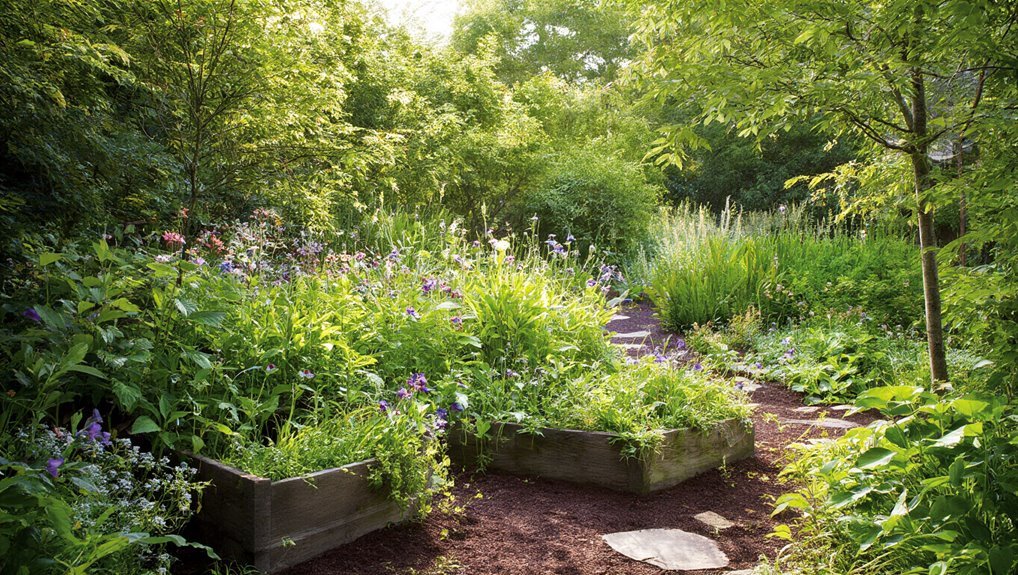
When you incorporate native plants into your garden, you’re not only supporting local ecosystems but also simplifying your gardening routine.
Native plants are adapted to your region’s climate, soil, and pests, which means they require less water and fewer chemicals compared to non-native species. You won’t need to spend hours watering or applying fertilizers, making your garden low-maintenance and more sustainable. Adding mulch around your native plants helps retain moisture, suppress weeds, and further reduces the need for garden maintenance.
Plus, they attract local pollinators like bees and butterflies, enhancing biodiversity. Choose plants that thrive in your area, and group them based on their sunlight and water needs for optimal growth.
You can also add edible flower seeds to your garden, allowing you to enjoy beautiful blooms that are both decorative and suitable for culinary use.
Use Container Gardening to Maximize Space
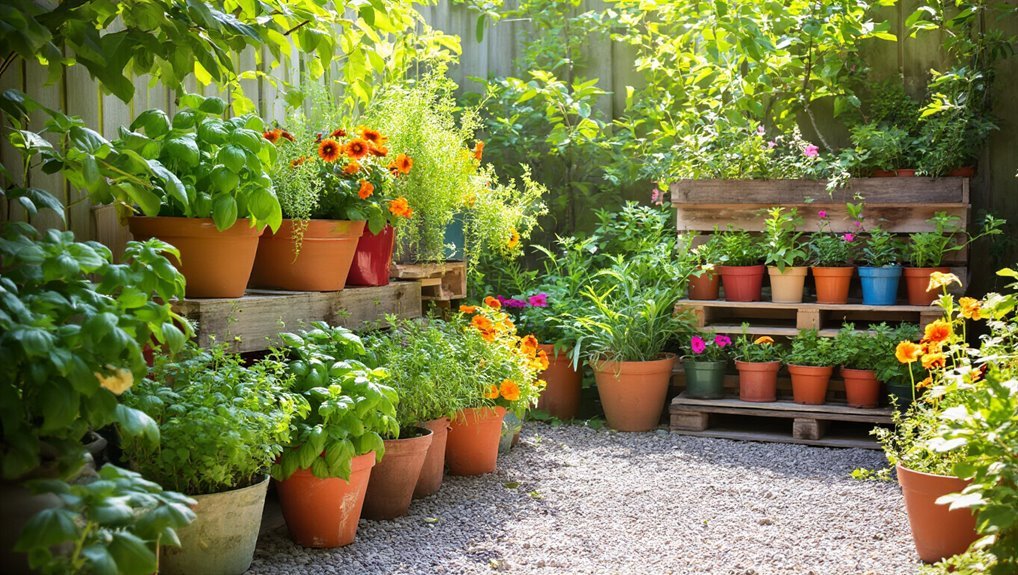
Incorporating native plants can lead to a lush garden, but if space is limited, container gardening is a fantastic way to maximize your area. You can easily create a vibrant garden by using pots, planters, or even repurposed containers.
Choose a variety of sizes and shapes to add visual interest and fit different spaces. Herbs, vegetables, and flowers thrive in containers, allowing you to grow your favorites right on your patio or balcony. For even easier maintenance, consider using self-watering planters to ensure your plants receive consistent moisture with minimal effort.
Make sure to use quality potting soil and consider the sunlight needs of your plants. With proper drainage and regular watering, your container garden will flourish.
Plus, it’s easy to rearrange or move your containers to catch the best light or change up your garden’s look. For an extra pop of greenery and to save even more space, consider using hanging planters to elevate your plants and add vertical interest to your backyard or balcony.
Explore Local Plant Swaps and Community Resources
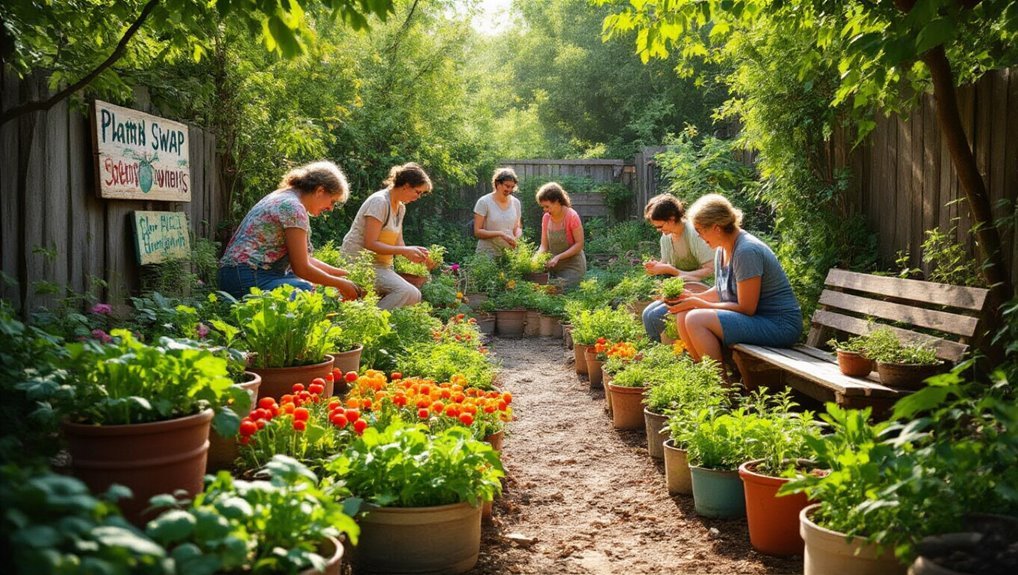
If you’re looking to expand your garden without breaking the bank, exploring local plant swaps and community resources is a great way to get started.
These events allow you to trade plants, seeds, and gardening supplies with fellow gardeners, often for free. Check local community centers, libraries, or social media groups for announcements about upcoming swaps. You’ll not only score new plants but also make connections with like-minded individuals. For even more success, referencing planting guides or calendars can help you determine the optimal times to plant the treasures you acquire.
Additionally, consider visiting community gardens where you can learn about growing techniques and sometimes even take home cuttings or seeds.
Many local gardening clubs offer workshops and resources for beginners, helping you cultivate your green thumb while saving money.
For even more inspiration and practical tips, be sure to explore essential reads for every gardening enthusiast to further enhance your gardening knowledge.
Dive into your community and watch your garden flourish!
DIY Garden Decor to Add Personality
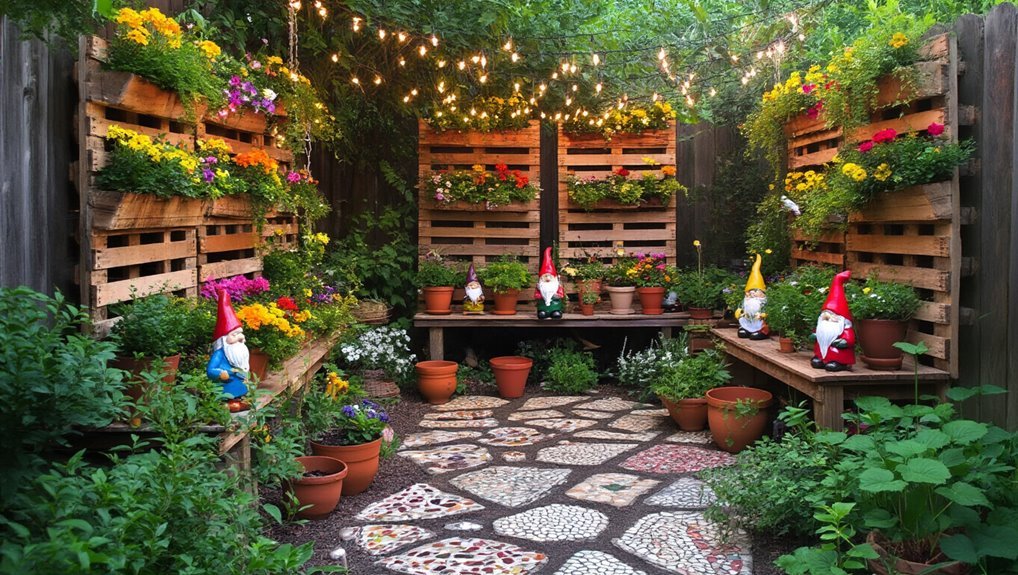
Connecting with fellow gardeners through plant swaps can inspire you to personalize your outdoor space.
DIY garden decor is a fantastic way to express your creativity while keeping costs low. Start by repurposing items you already have—think old wooden pallets for vertical gardens or tin cans as quirky planters.
You can also create painted rocks to mark your plants or use garden stakes to display fun quotes. Consider making a mosaic stepping stone using broken tiles or glass for a pop of color.
Wind chimes made from repurposed materials can add a delightful sound to your garden. Each unique piece not only enhances your garden’s charm but also tells your personal story, making your outdoor haven truly yours.
Frequently Asked Questions
What Are the Best Budget-Friendly Tools for Gardening Beginners?
For gardening beginners, essential budget-friendly tools include a sturdy hand trowel, pruning shears, a watering can, and gloves. These tools help you cultivate your garden effectively without breaking the bank or overwhelming your budget.
How Can I Attract Pollinators to My Backyard Garden?
To attract pollinators to your backyard garden, plant a variety of native flowers, avoid pesticides, and provide water sources. You’ll create a vibrant environment that supports bees, butterflies, and other essential pollinating creatures.
What Are the Benefits of Raised Garden Beds Versus Traditional Planting?
Imagine a Renaissance painting, where raised beds elevate your garden’s beauty. They improve drainage, reduce weeds, and offer easier access. You’ll enjoy healthier plants and a more organized space, making gardening a true pleasure.
How Do I Maintain a Budget-Friendly Garden Throughout the Season?
To maintain a budget-friendly garden throughout the season, focus on using native plants, composting kitchen scraps, and practicing crop rotation. Regularly check for pests and weeds to keep your garden thriving without extra costs.
Can I Garden in a Shaded Area, and How?
Yes, you can garden in a shaded area! Choose shade-tolerant plants like ferns or hostas, use raised beds for better drainage, and ensure adequate watering. Regularly check for pests and maintain soil health for success.
Conclusion
By embracing these budget-friendly backyard garden ideas, you’re not just saving money; you’re also contributing to a greener planet. Did you know that home gardens can reduce your grocery bill by up to 25%? With a little planning and creativity, you can cultivate your own oasis while enjoying fresh produce right at your doorstep. So gather your materials, get your hands dirty, and watch your garden thrive—all without breaking the bank!
